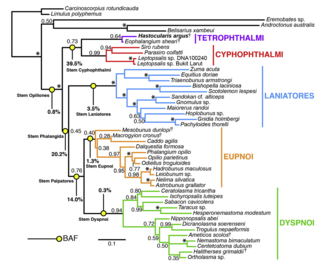
The Opiliones are an order of arachnids colloquially known as harvestmen, harvesters, harvest spiders, or daddy longlegs. As of April 2017, over 6,650 species of harvestmen have been discovered worldwide, although the total number of extant species may exceed 10,000. The order Opiliones includes five suborders: Cyphophthalmi, Eupnoi, Dyspnoi, Laniatores, and Tetrophthalmi, which were named in 2014.

Samooidea is a large superfamily in the Grassatores group of harvestmen. It includes around 380 species distributed throughout the tropics. They are characterized by the complex male genitalia, with eversible complementary sclerites.

Cosmetidae is a family of harvestmen in the suborder Laniatores. With over 700 species, it is one of the largest families in Opiliones. They are distributed from Argentina to the southern USA with the highest diversity in northern South America, Central America and Mexico. This Nearctic-Neotropical family comprises Opiliones with elaborate white/yellow/green/orange/red stripes and spots on the dorsal scutum and peculiar pedipalps strongly compressed and applied on the chelicerae.

Cyphophthalmi is a suborder of harvestmen, colloquially known as mite harvestmen. Cyphophthalmi comprises 36 genera, and more than two hundred described species. The six families are currently grouped into three infraorders: the Boreophthalmi, Scopulophthalmi, and Sternophthalmi.

The Sironidae are a family of harvestmen with more than 30 described species.

Troglosironidae is a family of harvestmen with thirteen described species in a single genus, Troglosiro, which is found on the island of New Caledonia, in the Pacific Ocean.

Ogoveidae is a family of harvestmen with three described species in one genus, Ogovea, which is found in equatorial West Africa.

The Neogoveidae are a family of harvestmen with 27 described species in eight genera. However, eight species of Huitaca, 17 species of Metagovea and 12 species of Neogovea are currently awaiting description.

The Pettalidae are a family of harvestmen with 75 described species in 10 genera. Several undescribed species are known or assumed in some genera.

Nipponopsalididae is a family of harvestmen with three described species in one genus, Nipponopsalis, which is found in East Asia.

Ischyropsalididae is a family of harvestmen with 31 described species in 3 genera, found in Europe and North America.
The Zalmoxidae are a family of harvestmen within the suborder Laniatores.

Harvestmen (Opiliones) are an order of arachnids often confused with spiders, though the two orders are not closely related. Research on harvestman phylogeny is in a state of flux. While some families are clearly monophyletic, that is share a common ancestor, others are not, and the relationships between families are often not well understood.

Tetrophthalmi is an extinct suborder of Opiliones that had both median and lateral eyes. First described in 2014, it is known from two extinct species. Phylogenetic analysis suggests that this eye arrangement is the ancestral condition for harvestmen, placing Tetrophthalmi and Cyphophthalmi in a basal position within Opiliones.
Gonzalo Giribet is a Spanish-American invertebrate zoologist and Alexander Agassiz Professor of zoology working on systematics and biogeography at the Museum of Comparative Zoology in Harvard University. He is a past president of the International Society for Invertebrate Morphology, of the Willi Hennig Society, and vice-president of the Sociedad Española de Malacología.

Theromaster is a genus of armoured harvestmen in the family Cladonychiidae. There are at least two described species in Theromaster, found in the eastern United States.

Travunioidea is a superfamily of armoured harvestmen in the order Opiliones. There are 4 families and more than 70 described species in Travunioidea.

Siro exilis is a species of mite harvestman in the family Sironidae. It is found in North America.
Huitaca is a genus of harvestmen belonging to the family Ogoveidae.















